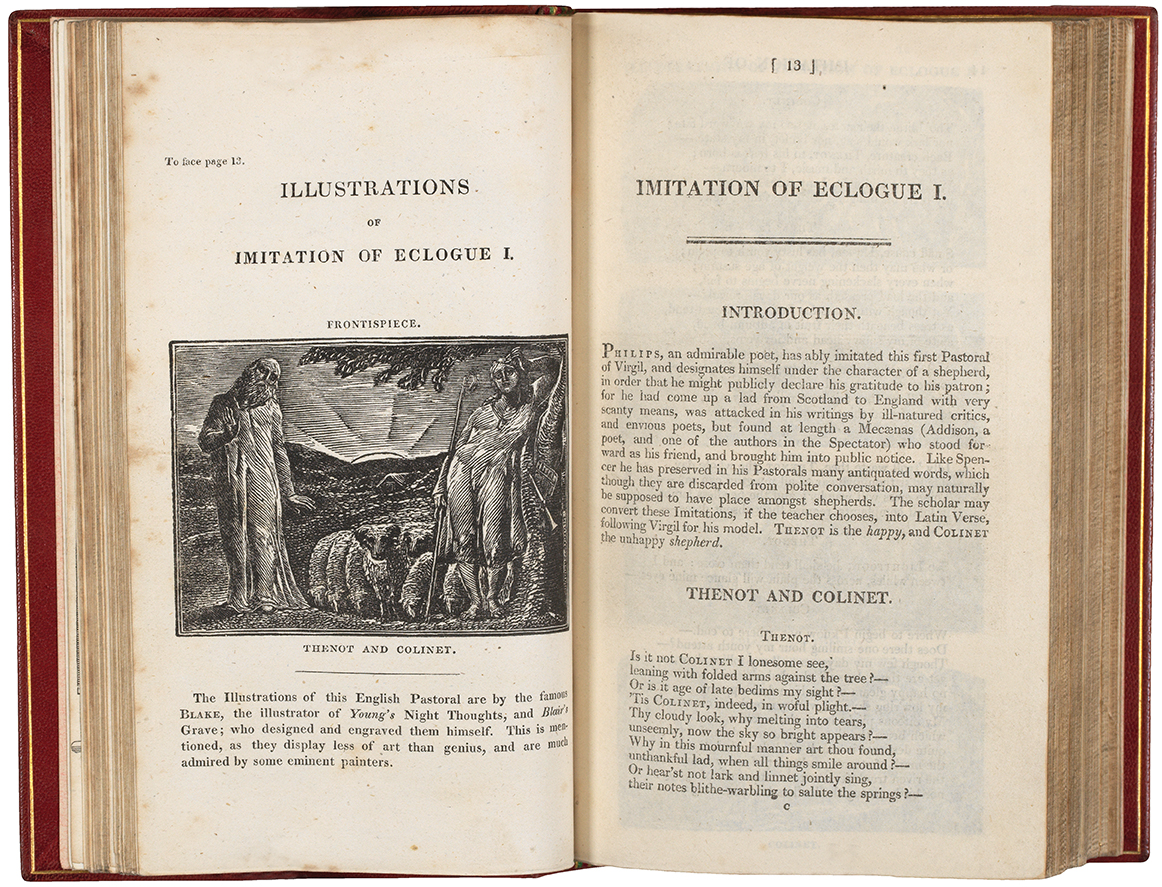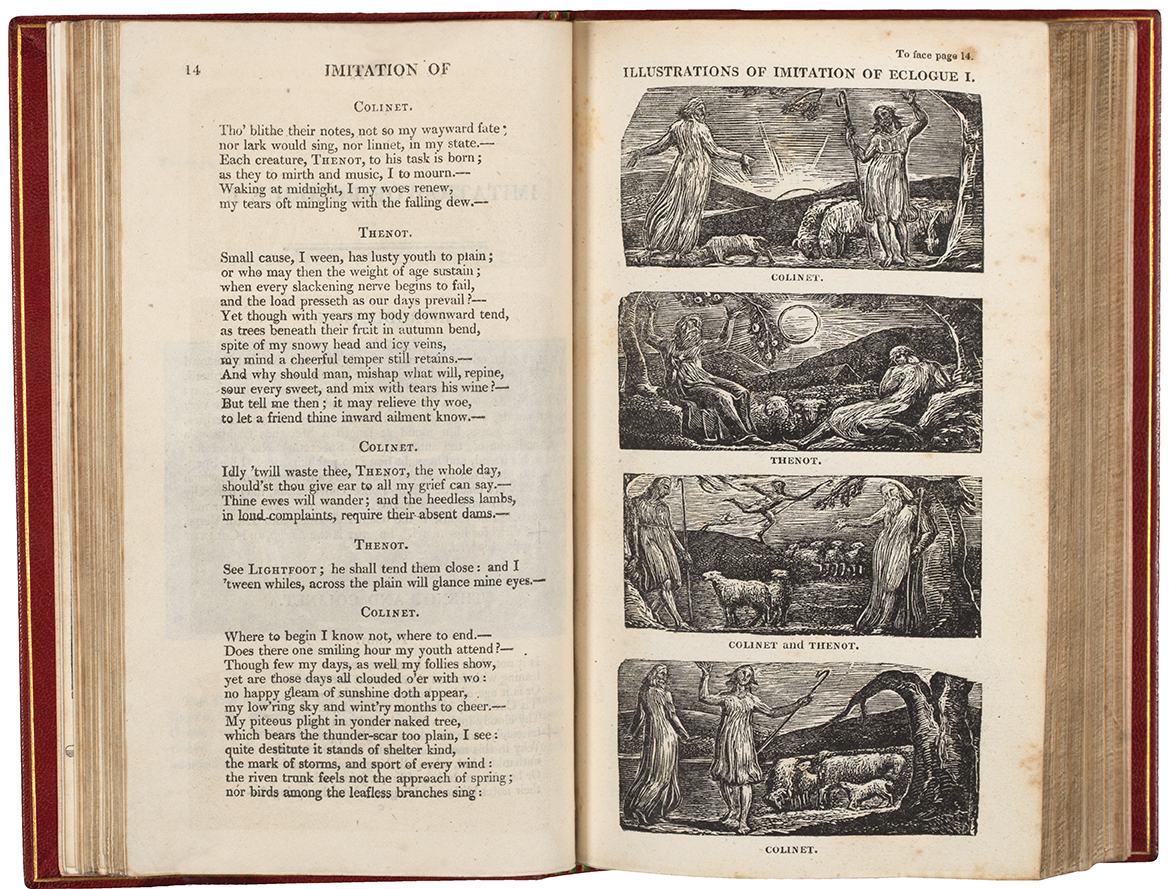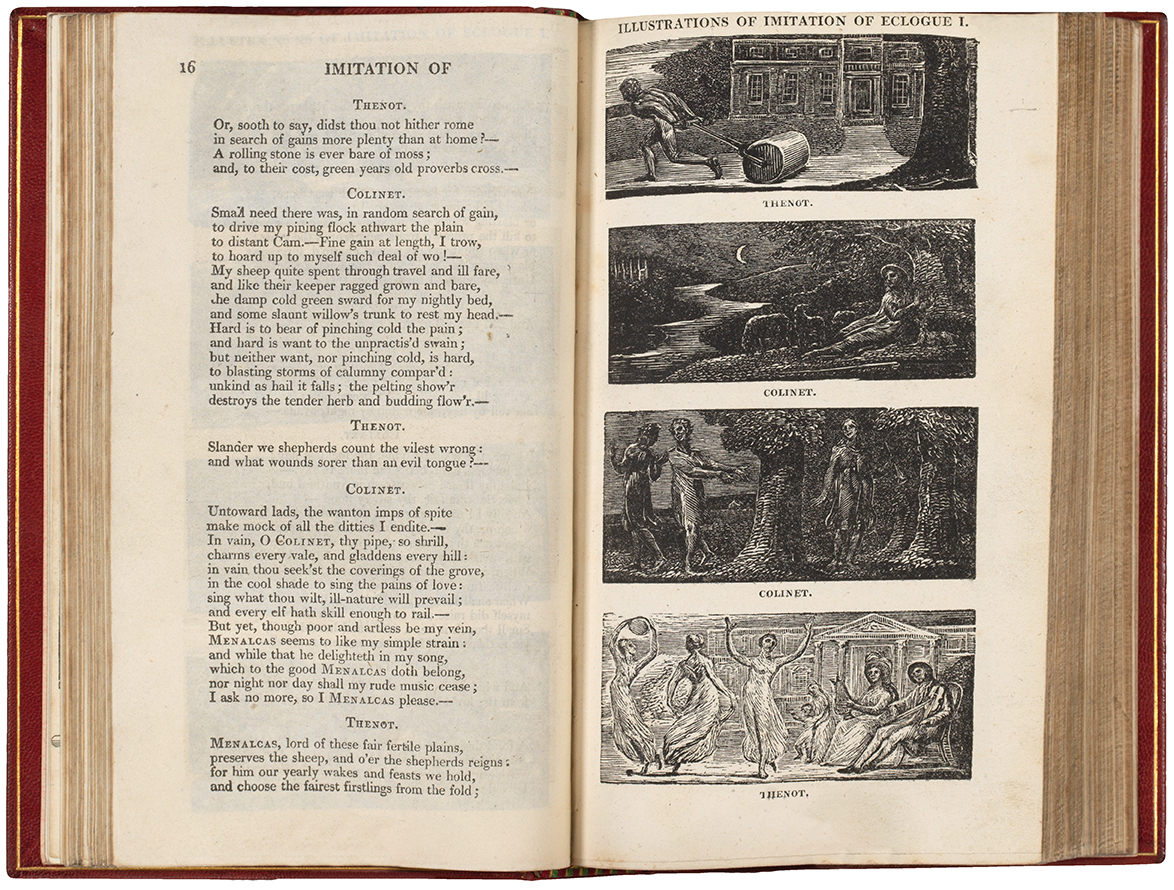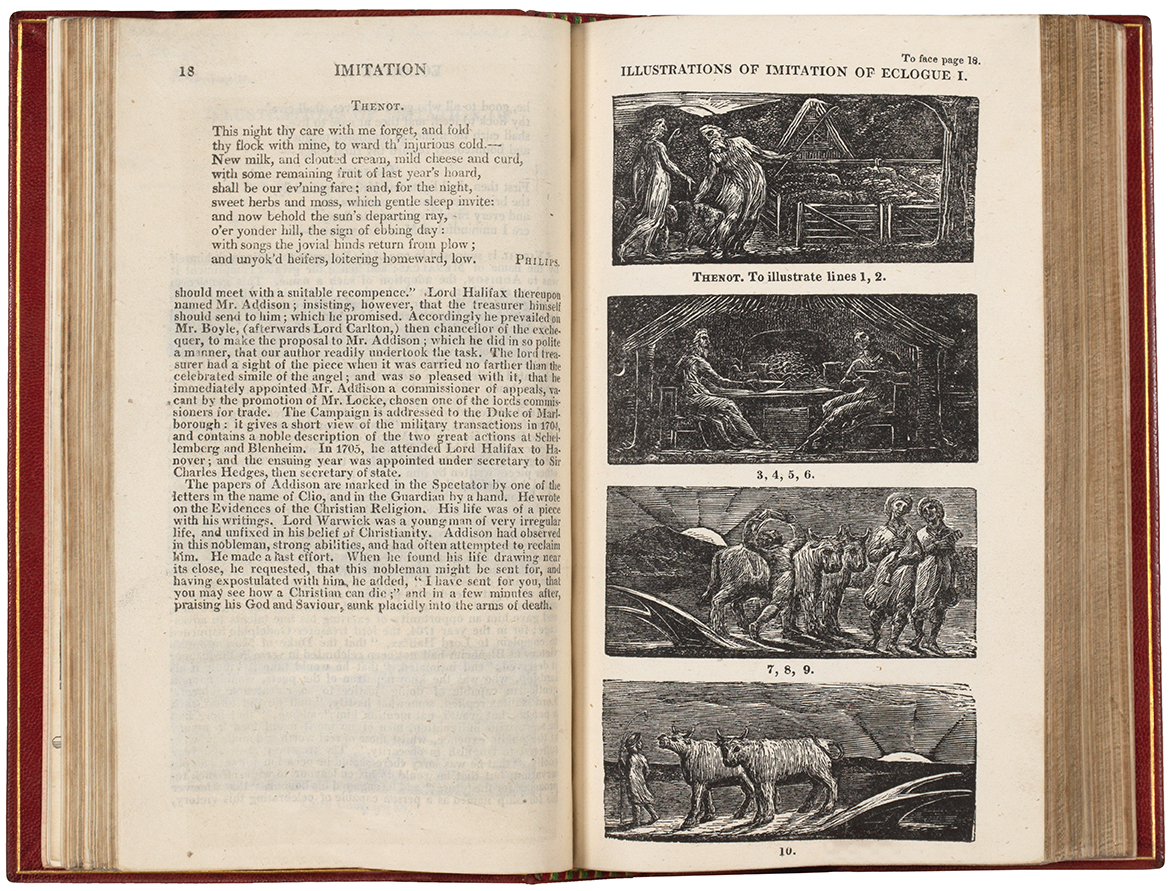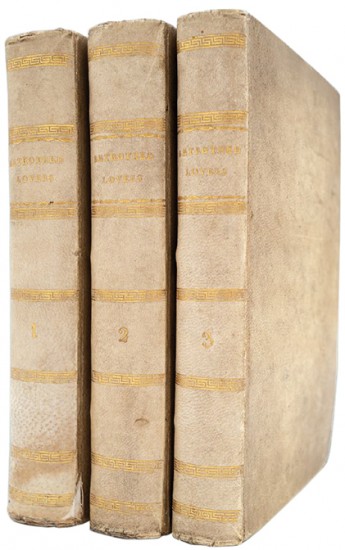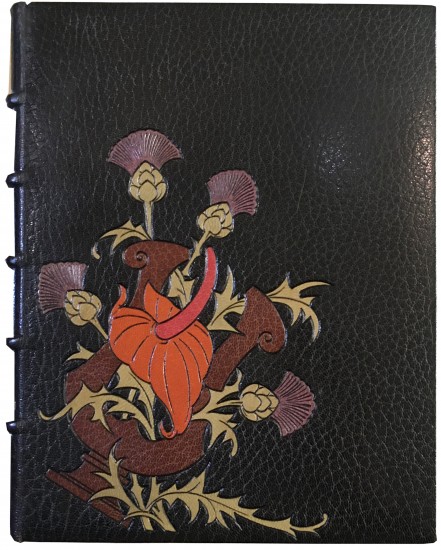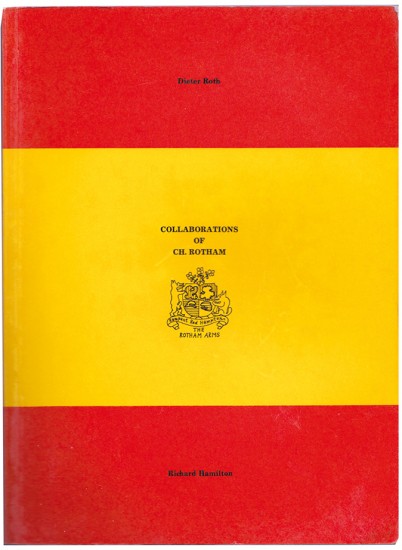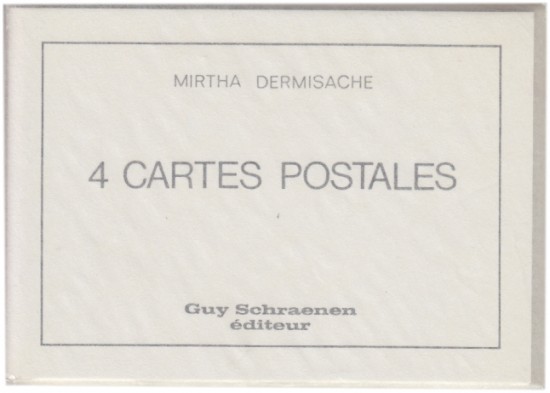The Pastorals of Virgil ... &c
Blake, William. Thornton, Robert John
London. Published by F. C. & J. Rivington; Longman and Co. &c. &c. 1821
Sold
Thornton's didactic Virgil with illustration by William Blake and bound in red morocco.
The third edition of Thornton's Virgil, although the first to include the 17 wood engravings designed and excecuted by William Blake, all printed four to a page, with the exception of one single sheet. In addition, three wood engravings in the series illustrating the 'Imitation of Eclogue I' were executed by another hand after Blake's designs (see below). A fourth wood engraving was cut by Byfield after a drawing by Blake which is itself based on a design by Poussin. Six copper-plate intaglio engravings of classical busts and coins are signed by Blake as designer and engraver, but are clearly based on the work of another (at the very least the sculptor of the busts).
The first edition of Thornton's Virgil - it is usually and widely known thus - was published in 1812 without plates, woodcuts were then issued separately in 1814 and the text and illustrations were brought together in the second edition of 1819. For this third edition, more plates were commissioned, hence the involvement of William Blake. Blake's efforts were not well received; some of the plates were entirely recut and the others, as Gilchrist explains, were saved only by the 'warm admiration' of them by Sir Thomas Lawrence, James Ward, Linnell and others. The blocks 'moreover, proved in the first instance too wide for the page and were, irrespective of the composition, summarily cut down to the requisite size by the publisher'.
'The Illustrations of this English Pastoral are by the famous BLAKE, the illustrator of Young's Night Thoughts, and Blair's Grave; who designed and engraved them himself. This is mentioned, as they display less of art than genius, and are much admired by some eminent painters.' (Thornton's note beneath Blake's frontispiece for the 'Illustrations of Imitation of Eclogue I').
'The poem chosen for Blake's attention was Ambrose Phillips's [sic] imitation of Virgil's first eclogue. Blake carried out this commission by making his first and only wood engravings. It appears from early proofs that, except for the initial plate, he cut them in groups of four on large blocks. They were so printed, but since the blocks proved too big for Thornton's page, the individual engravings had first to be separated and cut down ... Despite their undignified debut, these little engravings had a potent influence on those with eyes to see.' (Ray).
The full and extensive title reads as follows: 'The Pastorals of Virgil, with a Course of English Reading, Adapted for Schools: In Which All The Proper Facilities are Given, Enabling Youth to Acquire The Latin Language, in the Shortest Period of Time. Illustrated with 230 Engravings.'
[Bentley 504; Russell 30; Ray 7; Keynes 77; Binyon 137 - 153].
The third edition of Thornton's Virgil, although the first to include the 17 wood engravings designed and excecuted by William Blake, all printed four to a page, with the exception of one single sheet. In addition, three wood engravings in the series illustrating the 'Imitation of Eclogue I' were executed by another hand after Blake's designs (see below). A fourth wood engraving was cut by Byfield after a drawing by Blake which is itself based on a design by Poussin. Six copper-plate intaglio engravings of classical busts and coins are signed by Blake as designer and engraver, but are clearly based on the work of another (at the very least the sculptor of the busts).
The first edition of Thornton's Virgil - it is usually and widely known thus - was published in 1812 without plates, woodcuts were then issued separately in 1814 and the text and illustrations were brought together in the second edition of 1819. For this third edition, more plates were commissioned, hence the involvement of William Blake. Blake's efforts were not well received; some of the plates were entirely recut and the others, as Gilchrist explains, were saved only by the 'warm admiration' of them by Sir Thomas Lawrence, James Ward, Linnell and others. The blocks 'moreover, proved in the first instance too wide for the page and were, irrespective of the composition, summarily cut down to the requisite size by the publisher'.
'The Illustrations of this English Pastoral are by the famous BLAKE, the illustrator of Young's Night Thoughts, and Blair's Grave; who designed and engraved them himself. This is mentioned, as they display less of art than genius, and are much admired by some eminent painters.' (Thornton's note beneath Blake's frontispiece for the 'Illustrations of Imitation of Eclogue I').
'The poem chosen for Blake's attention was Ambrose Phillips's [sic] imitation of Virgil's first eclogue. Blake carried out this commission by making his first and only wood engravings. It appears from early proofs that, except for the initial plate, he cut them in groups of four on large blocks. They were so printed, but since the blocks proved too big for Thornton's page, the individual engravings had first to be separated and cut down ... Despite their undignified debut, these little engravings had a potent influence on those with eyes to see.' (Ray).
The full and extensive title reads as follows: 'The Pastorals of Virgil, with a Course of English Reading, Adapted for Schools: In Which All The Proper Facilities are Given, Enabling Youth to Acquire The Latin Language, in the Shortest Period of Time. Illustrated with 230 Engravings.'
[Bentley 504; Russell 30; Ray 7; Keynes 77; Binyon 137 - 153].
pp. (i), xii, 12, v - xxiv, 214, (blank); 215 - 592, (blank). Plates hors-texte and not included in the pagination (although with printed indication of placement). 2 vols. 8vo. (178 x 112 mm). Contents: Wood-engraved frontispiece and printed title to each vol., vol. I with Thornton's dedication to Rev. Dr. Sleath, 'Address', quotation from Cicero, 'Opinions', 'Testimonials', 'Contents', 'Preface' and Pope's 'A Discourse on Pastoral Poetry' and Virgil's Bucolica, Eclogues I - IV, each with introduction, 'Moral' and 'Imitation' with notes and illustration, vol. II with Eclogues V - X, final leaf with Thornton's 'Concluding Remark' verso and printer's credit, terminal blanks in both vols. Illustration: 232 engraved illustrations including frontispieces and 3 maps (two folding) - Wood-engraved frontispieces to each vol., four engraved plates by William Blake in vol. I ('Publius Virgilius Maro', 'Octavius Augustus Caesar', 'Theocritus' and 'From Antique Coins') each with explanatory text, two in vol. II ('Caius Julius Caesar' and 'Epicurus'), plate with 'Bellona Inciting Civil War' (repeated in vol. II as 'The Horrors of War'), folding map ('Mundi Antiqui Tabula', map 'Antiquae Italiae Tabula', frontispiece to each Eclogue and plates with numerous wood-engraved vignette illustrations (usually 3, 4 or 5 to a page with occasional repeats), folding map 'Macedonia, Thraeia, et Graecia Antiqua' in Eclogue III. Full-page plates and 17 wood-engravings by William Blake, 4 wood-engravings after Blake and six plates engraved and drawn by Blake; printed text in English and Latin with occasional quotations in Greek. Full red crushed morocco by Sangorski & Sutcliffe with their signature gilt, boards with double gilt rules, banded spines with gilt titles and rules in six compartments, pink marbled endpapers, turn-ins ruled in gilt, a.e.g.
#46554

